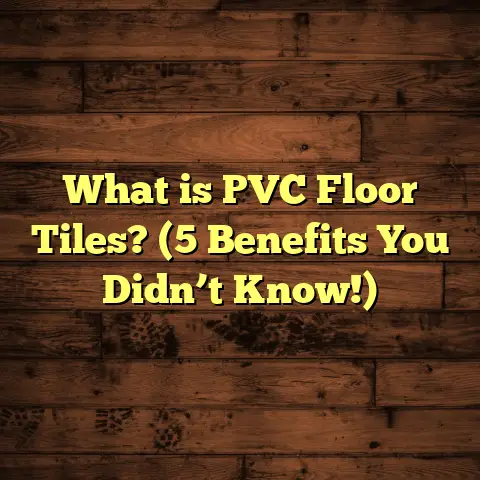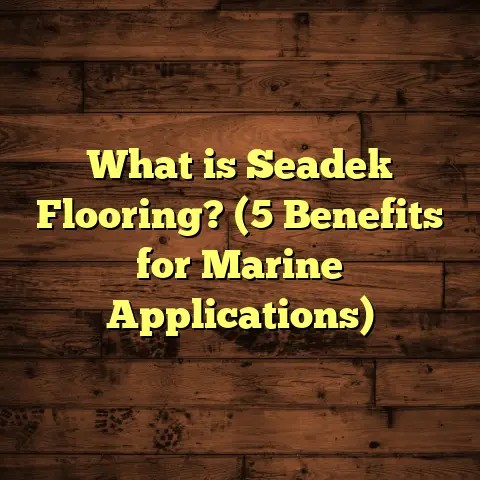What is Cabin Grade Wood Flooring? (5 Benefits for Your Home)
I’ve always been a fan of getting the most bang for my buck, especially when it comes to home improvements. Flooring can be a major investment, but finding an option that combines durability, style, and affordability is a win in my book. That’s why I want to talk about something that might not be on everyone’s radar but deserves some serious attention: Cabin Grade Wood Flooring. It’s a fantastic choice that offers great value for money, and I’ll share why it could be perfect for your home.
What is Cabin Grade Wood Flooring?
So, what exactly is cabin grade wood flooring? Simply put, it’s a type of hardwood flooring that embraces natural imperfections like knots, mineral streaks, and color variations. These characteristics give it a rustic, authentic look that feels warm and lived-in—kind of like the floors you’d expect in a cozy mountain cabin. The wood itself is typically sourced from species like pine, fir, or spruce, which tend to be softer woods compared to traditional hardwoods like oak or maple.
Cabin grade wood is graded at the lowest tier in standard wood grading systems because of these visible imperfections. But unlike higher-grade floors that aim for uniformity and flawlessness, cabin grade celebrates the unique character of each plank. This means you get a floor with personality and charm that feels natural and inviting.
Here’s a quick snapshot of what makes cabin grade wood flooring stand out:
- Species: Commonly pine, fir, spruce
- Grade: Lower grade (often called “cabin” or “rustic” grade)
- Appearance: Knots, streaks, color variation
- Hardness: Softer than typical hardwood floors (Janka hardness around 400-700 for pine vs. 1,200+ for oak)
- Cost: Typically $3 to $6 per square foot (material only), quite budget-friendly
- Installation time: Can be installed in about 2-3 days for an average 1,000 sq ft room by pros
When I first started installing cabin grade floors about 10 years ago in homes around the Pacific Northwest, it was mostly for vacation cabins and rustic lodges. But over time, I noticed more homeowners were drawn to this look for their main homes too. The blend of affordability and character is tough to beat.
Why Does It Cost Less?
You might wonder why cabin grade flooring is cheaper than other hardwood options. The answer lies in the grading and the wood species used. Because the wood contains more natural “flaws,” it doesn’t require the same level of processing or selection as higher-grade planks. Plus, softer woods like pine grow faster and are more abundant, reducing costs significantly.
5 Benefits of Cabin Grade Wood Flooring for Your Home
Now that you know what cabin grade wood flooring is, let me walk you through some benefits I’ve experienced firsthand after installing it in dozens of homes.
1. Great Value for Money Without Sacrificing Style
If you want beautiful wood floors but are working with a tighter budget, cabin grade wood is a smart pick. I recently worked with a client in Oregon who wanted real wood flooring but couldn’t afford the $10-$12 per sq ft price tag of premium oak. We chose cabin grade pine instead, which came in at just $4.50 per sq ft installed, including finish.
The result? A warm, inviting floor with lots of character that perfectly matched their rustic farmhouse style. It looked expensive but didn’t break their budget.
It’s interesting how many people assume lower price means lower quality. Cabin grade floors defy that by offering genuine hardwood with authentic character at a fraction of the cost.
2. Unique Character You Won’t Find in Uniform Floors
One thing I love about cabin grade wood is that no two planks are alike. The knots, color variations, and grain patterns tell a story. This uniqueness adds personality and charm to any room.
I remember installing a cabin grade fir floor in a lakeside retreat last year. The homeowner told me she loved how the floor felt “alive” because of its natural imperfections. It gave the space an organic vibe that polished hardwood just can’t replicate.
Some people shy away from knots because they worry about durability or aesthetics—let me assure you that with proper finishing and maintenance knots don’t cause problems; they add warmth and a lived-in feel.
3. Warmer and Softer Underfoot
Cabin grade woods like pine are softer than traditional hardwoods, which makes them more forgiving on your feet and joints if you spend a lot of time standing or walking around.
From my own experience, after switching my home office floor to cabin grade pine, I noticed less fatigue at the end of long workdays compared to when I had tile or harder wood floors before.
Softwoods also tend to retain heat better than stone or tile floors — which can make a big difference in colder climates or during winter months.
4. Faster Installation Time
Because the planks are often wider (typically 5-7 inches wide) and come unfinished or prefinished with simpler finishes, installation usually goes faster than with other types of hardwood.
For example, the average 1,200 sq ft home takes about 2 to 3 days with a professional crew for cabin grade flooring compared to up to a week for more complex hardwoods like hickory or walnut.
This means less disruption to your daily life during installation—and lower labor costs overall.
5. Environmentally Friendly Choice
Since many cabin grade woods come from fast-growing softwood trees harvested from sustainably managed forests, choosing this option can be better for the environment than exotic hardwoods.
I’ve worked with suppliers who source their pine locally from Washington and Oregon forests certified by the Forest Stewardship Council (FSC). This means less transportation emissions and support for responsible forestry practices.
Plus, because these trees grow quickly—often within 20-30 years—using softwoods helps reduce pressure on older hardwood forests that take decades or centuries to mature.
Comparing Cabin Grade Wood Flooring to Other Flooring Options
I often get asked how cabin grade wood stacks up against other common floorings like laminate, engineered hardwood, or luxury vinyl plank (LVP). Let me break down some key differences from my experience:
| Flooring Type | Cost per Sq Ft | Durability | Appearance | Installation Time | Maintenance |
|---|---|---|---|---|---|
| Cabin Grade Wood | $3 – $6 | Moderate (softwood) | Rustic knots & color variation | 2 – 3 days | Requires refinishing |
| Laminate | $1 – $3 | High (scratch-resistant) | Can mimic wood but uniform | 1 – 2 days | Easy (no refinishing) |
| Engineered Hardwood | $5 – $10 | High | Real wood veneer; more uniform | 3 – 5 days | Refinishing limited |
| Luxury Vinyl Plank (LVP) | $2 – $5 | Very high | Wide style range; synthetic | 1 – 2 days | Very low |
| Premium Hardwood (Oak) | $8 – $15 | Very high | Smooth and consistent grain | 4 – 7 days | Can be refinished |
Each type has its own strengths depending on your priorities—budget, look, durability—but cabin grade shines where you want character without spending a fortune or sacrificing authenticity.
Real-Life Case Study: Cabin Grade Flooring in a Renovated Farmhouse
Here’s a more detailed story from one of my favorite projects where cabin grade flooring really made a difference.
I was hired by a couple restoring an old farmhouse in Montana’s Bitterroot Valley. They wanted to keep the home’s historic charm but needed affordable flooring that wouldn’t clash with exposed beams and vintage fixtures.
We chose cabin grade spruce sourced from local mills within 100 miles of their property. The wood had beautiful knots and natural color shifts that complemented the rugged mountain setting perfectly.
Project Details:
- Home size: 1,800 sq ft
- Flooring installed: Cabin grade spruce, 6-inch wide planks
- Cost: $4 per sq ft installed (materials + labor)
- Installation time: 4 days total
- Finish: Matte polyurethane for durability without gloss
- Maintenance plan: Annual cleaning + refinishing every 7 years
The floors instantly warmed up the space and became a talking point among guests. The owners loved how each knot seemed to tell part of the house’s story.
Even after two winters with snow tracked inside daily, only minor signs of wear appeared — easy to fix with spot sanding and refinishing.
This project showed me just how well cabin grade wood can blend beauty with practicality when chosen thoughtfully.
How to Choose the Right Cabin Grade Wood Flooring for Your Home
If you’re considering cabin grade floors, here are some tips I always share with clients:
Species Matters
While pine is most common because it’s affordable and widely available, fir and spruce also make great options depending on your region.
Fir tends to be slightly harder than pine (Janka hardness ~600 vs. ~400) which means better resistance to dents.
Spruce offers nice grain patterns but can be softer overall.
Think about your lifestyle — if you have kids or pets who might scratch floors more often, fir might be better long-term.
Width & Thickness
Cabin grade planks typically range from 5 to 7 inches wide — wider boards show off more grain variation but can expand/contract more in humidity changes.
Thickness usually varies from 3/4 inch (solid) to thinner engineered versions if available; thicker planks allow refinishing multiple times over decades.
Finish Options
Unfinished wood lets you customize stain color but takes longer to install as finishing happens onsite.
Prefinished floors save time but limit your color choices somewhat.
Matte or satin finishes tend to hide scratches better than high gloss on rustic woods like this.
Color Selection
Natural pine ranges from pale yellow tones to richer amber shades depending on origin and treatment.
Some manufacturers offer lightly stained options that emphasize knots without hiding them — great if you want rustic but slightly polished looks.
Budget Considerations
Expect materials alone around $3-$6 per sq ft depending on species and finish choice.
Labor typically adds another $2-$4 per sq ft depending on location and complexity — so total installed cost averages $5-$10 per sq ft.
If budget is tight but you want real wood floors with character, cabin grade beats many higher-end hardwood options hands down.
Installation Process: What You Can Expect
If you decide on cabin grade wood floors, here’s what happens during installation based on my years of experience:
Pre-Installation Prep
- The subfloor must be clean, level, and dry.
- Any moisture issues should be addressed before laying wood.
- Acclimate wood planks onsite for several days so they adjust to humidity levels — especially important for softwoods prone to expansion/contraction.
Installation Techniques
- Most installers use nail-down or staple-down methods for solid cabin grade planks.
- Glue-down methods are less common but possible if subfloor allows.
- Planks are staggered during installation to avoid repeating knot patterns too closely.
Finishing Touches
- If unfinished planks are used, sanding happens after installation to smooth joints.
- Finish coats (polyurethane or oil-based) are applied onsite.
- Prefinished planks skip this step but installers check seams carefully.
Timeframe
For an average 1,200 sq ft room:
- Prep & acclimation: 3-5 days
- Installation: 2-3 days
- Finishing (if needed): 1-2 days drying time between coats
So total project time runs about one week from start to finish if unfinished; less if prefinished.
Long-Term Maintenance & Care Tips
Taking care of cabin grade floors helps them last longer and look better year after year:
Regular Cleaning
- Sweep or vacuum often to remove dirt grit that scratches surfaces.
- Use damp mops sparingly; avoid excessive water.
- Clean spills immediately to prevent staining soft woods.
Prevent Damage
- Place felt pads under furniture legs.
- Avoid dragging heavy objects across floors.
- Use area rugs in high traffic areas like entrances or kitchens.
Refinishing
Cabin grade softwoods can dent easier than harder woods but also sand down well when refinished every 5 to 7 years depending on wear.
Proper refinishing restores beauty and protects against moisture damage.
Environmental Impact: Why Cabin Grade Wood Can Be Green Choice
Sustainability matters more now than ever when choosing building materials:
- Softwood trees like pine grow quickly (20–30 years) compared to hardwoods (50–100+ years).
- Many suppliers source from FSC-certified forests ensuring responsible harvesting.
- Local sourcing reduces transportation emissions.
- Using lower-grade wood minimizes waste since these planks might otherwise be discarded or used for lower-value purposes.
In fact, some mills run programs that recycle leftover cutoffs into pellets for heating — reducing overall environmental footprint.
Design Ideas & Styles Using Cabin Grade Wood Floors
Because of its distinct appearance, cabin grade flooring lends itself beautifully to many design styles:
Rustic & Farmhouse
The knots and natural streaks fit perfectly with exposed beams, stone fireplaces, and vintage furnishings.
Coastal & Cottage
The softer colors and lived-in look pair well with light walls and nautical décor themes.
Modern Rustic
Pair wide plank cabin grade floors with clean lines and minimalist furniture for an updated rustic aesthetic that feels fresh yet cozy.
Mountain Lodge & Cabin
This is the classic use case — floors echoing natural surroundings create warmth against panoramic views and rough-hewn wood accents.
How Much Does Cabin Grade Wood Flooring Cost?
Let’s break down costs with specifics so you have realistic expectations:
| Expense | Cost Range (USD) |
|---|---|
| Material (per sq ft) | $3 – $6 |
| Professional Installation | $2 – $4 per sq ft |
| Finishing Supplies | $0.50 – $1 per sq ft |
| Removal of Old Flooring | $1 – $3 per sq ft |
| Additional Materials (underlayment etc.) | $0.50 – $1 per sq ft |
For an average home size of about 1,200 sq ft:
- Materials: $3,600 – $7,200
- Installation: $2,400 – $4,800
- Total: Approximately $6,000 – $12,000
Keep in mind prices vary widely by region — urban areas like Seattle or Portland tend toward higher labor costs compared to rural zones.
Common Questions About Cabin Grade Wood Flooring
Q: Will knots cause my floor to weaken or crack?
A: No. Knots are natural parts of the wood grain; when properly dried and finished they don’t compromise structural integrity but add character instead.
Q: How does softwood flooring hold up over time?
A: While softer than oak or maple, softwoods like pine still last decades with regular care and refinishing every few years. Their dents can add charm rather than detract if embraced as part of the look.
Q: Can I install cabin grade flooring myself?
A: If you have carpentry experience it’s possible — but professional installation ensures proper acclimatization, moisture control, and finishing leading to better results long-term.
Wrapping Up My Thoughts on Cabin Grade Wood Floors
Cabin grade wood flooring offers a winning combination of affordability, character, comfort underfoot, ease of installation, and environmental friendliness. It’s not perfect for every home style but shines brilliantly in spaces where warmth and personality matter most.
Whether you’re renovating an old farmhouse like I did in Montana or updating a mountain retreat near Seattle or Vancouver — cabin grade flooring could be just what you need to bring natural beauty into your living space without overspending.
If you’re curious about options or want advice tailored to your project location or budget constraints — just ask! I’m always happy to share insights gained through years working hands-on with this unique flooring material.





